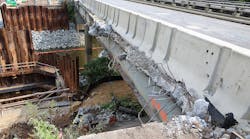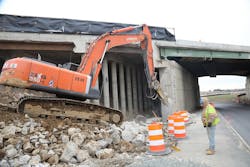It was 1 o’clock on a January afternoon when a 40-lb. hunk of concrete fell from a New Jersey bridge through truck driver Earl Egbert’s windshield. He remembers nothing at all about it.
The accident left him blind in one eye, slivers of debris still jammed in his brain and hobbled. The 56-year old trucker, who had been on the road since 1998, can no longer drive his 18-wheeler, and his days often are spent going from one doctor to another.
“A terrible thing happened to me. I was just going about by my business, and this happened. I was just working,” he said from his home in Connecticut. “My legs are not walking so good. I use a walking stick. So many things, my friend. So many things…”
The concrete fell from a pedestrian bridge over Route 4 West in Teaneck, a road he has taken before without incident. His truck was empty at the time, he says, and he was going to make a pick-up.
“I did not know anything, after I got hit. I didn't know when the police came or when the ambulance came,” he explained. “I later watched the video that was on the truck and saw the stretcher go into the ambulance. I didn't know nothing. I was a complete pass-out.”
New Jersey DOT officials would not comment on Egbert’s incident.
This was not an isolated case. About a month later, an electrical conduit in the Lehigh Tunnel on the Northeast Extension of the Pennsylvania Turnpike fell onto a truck killing 70-year old driver Howard Sexton of Mickleton, NJ. Despite being hit, Sexton made it through the tunnel and pulled over to the shoulder, according to Pennsylvania State Police. Troopers found him dead behind the wheel.
A check of news articles over past years show many cases of motorists being hit, sometimes killed, by pieces of bridges and tunnels falling onto their vehicles.
It’s no secret that the U.S. infrastructure is crumbling. Of the more than 600,000 bridges in the nation, about 10 percent are deemed structurally deficient, according to data from federal and state agencies. States with the most structurally deficient bridges are Iowa, Pennsylvania, Oklahoma, Missouri and Illinois.
For drivers, the only thing they can do is not operate on or under these bridges but that’s not always possible. “On average there's 160 bridges that should not be traveled on in every state; stay off these bridges,” noted Barry LePatner, a construction lawyer who lectures and educates people about the nation’s deficient infrastructure, particularly bridges. “Your children are in school buses on them. They shouldn’t be traveling on them every day. The public is at risk and every engineer in this field will agree. Don't go on these bridges. They could fall at a moment's notice. I’m not trying to scare you. This is the reality of it.”
LePatner, author of Too Big to Fall: America's Failing Infrastructure and The Way Forward, spends most of his time speaking about infrastructure to engineer, architects, regulators, the general public and others. He has developed a website www.saveourbridges.com that shows dangerous bridges in each state.
“I don't care where you are, you can put your zip code in and up will come the most dangerous bridges in your area, which you should not travel on. Not only have those bridges been identified as structurally deficient, but they are also ‘fracture-critical,’ something the government does not want to really publicize but they do acknowledge.”
A failure-critical bridge is one of 8,000 bridges that were built in the '60s and '70s where there was no redundancy. “Today we put in lots of additional features,” LePatner said. “If parts break there are other structural supports to keep the bridges standing. In a fracture-critical bridge, if one piece breaks the whole bridge goes down.”
In 2002, LePatner was honored by the American Institute of Architects with its highest award to a non-architect when he was given an honorary AIA membership. He says that many civil engineers come to him to whistle-blow about a dangerous bridge, but they can’t go public with their findings because their companies have contracts with state agencies.
He is vexed by the lack of political will to fix the situation. “Nobody is taking a leadership role on this issue. There are people on [Congressional] committees, but the public does not see anybody standing up and saying, ‘Here's the true state of our infrastructure needs.’ What we really need and what I have spoken about for about a half-dozen years, is that the only change we're going to see in this terrible condition is when the public rises up and realizes that they are at risk every day.”
He explains that the government purposely is choosing not to pay attention to this critical need. “This is not a hoax. This is not Chicken Little. It's physics. If you hold your cup of coffee and you let it go does anybody believe it's going to stop in the middle and suspend itself? No. Gravity will pull it to the ground and every one of our bridges without the proper maintenance is going to fall to the ground and every engineer can give you an example of what I'm saying.”
He added that not only are lives at stake but so is our economy. “We're paying a huge price in the damage to our cars and our trucks… That's the sad truth about our country. As rich as we are, as wonderful as we are, we have chosen to put our heads into the ground on one of the most significant issues that affect our nation's security. It affects our supply chain, it affects our concept of globalism and shipping. Three-fourths of all of our exports go over our roads and bridges.”
As for Egbert, his attorney Patrick Metz has filed a tort claim against the state of New Jersey, the first step before filing a lawsuit.
“I got another e-mail from somebody this morning, and the same thing happened to him, almost in the exact same spot,” Metz said. “So, they're (DOT) aware of these bridge crumbling, and we've all been aware of them crumbling for decades now, especially because of the freeze-thaw cycle. What has to happen before something is done? [Bridge debris] going through a school bus?”
“I am very lucky to be alive,” Egbert said. “A lot of drivers don't make it. This could happen to anybody, anyone, at any time.”




